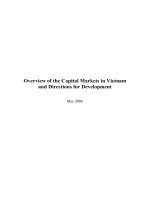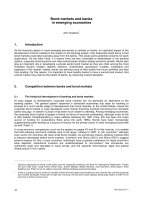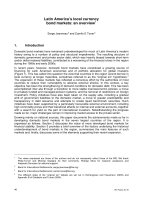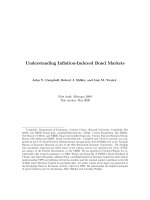Mortgage Markets
Bạn đang xem bản rút gọn của tài liệu. Xem và tải ngay bản đầy đủ của tài liệu tại đây (357 KB, 44 trang )
1
Chapter 9
Mortgage Markets
Financial Markets and Institutions, 7e, Jeff Madura
Copyright ©2006 by South-Western, a division of Thomson Learning. All rights reserved.
2
Chapter Outline
Background on mortgages
Residential mortgage characteristics
Creative mortgage financing
Institutional use of mortgage markets
Valuation of mortgages
Risk from investing in mortgages
Mortgage-backed securities
Globalization of mortgage markets
3
Background on Mortgages
A mortgage is a form of debt that finances investment in property
The debt is secured by the property
The mortgage is the difference between the down payment and the
value to be paid for the property
Financial institutions such as savings institutions and mortgage
companies originate mortgages
They accept mortgage applications and assess the creditworthiness
of the applicants
The mortgage contract specifies the mortgage rate, the maturity, and
the collateral that is backing the loan
The originator charges an origination fee
The originator may earn a profit from the difference between the
mortgage rate and the rate that it paid to obtain funds
4
Background on Mortgages (cont’d)
The level of mortgage debt has risen over time
Mortgage debt rises at a slower rate during
recessions
The majority of mortgage debt outstanding is
on one- to four-family properties
5
Residential Mortgage
Characteristics
The mortgage contract should specify:
Whether the mortgage is federally insured
The amount of the loan
Whether the interest rate is fixed or adjustable
The interest rate to be charged
The maturity
Other special provisions
6
Residential Mortgage
Characteristics (cont’d)
Insured versus conventional mortgages
Federally insured mortgages guarantee loan
repayment to the lending financial institution
The insurance fee is 0.5 percent of the loan amount
The guarantor is either the FHA or the VA
The maximum mortgage amount is limited by law
The volume of FHA loans has consistently exceeded that of
VA loans
Conventional mortgages can be privately insured
The private insurance premium is typically passed to the
borrowers
7
Residential Mortgage
Characteristics (cont’d)
Fixed-rate versus adjustable-rate mortgages
A fixed-rate mortgage locks in the borrower’s
interest rate over the life of the mortgage
The periodic interest payment is constant
Financial institutions that hold fixed-rate mortgages are
exposed to interest rate risk if funds are obtained from short-
term sources
Borrowers with fixed-rate mortgages do not benefit from
declining rates
8
Residential Mortgage
Characteristics (cont’d)
Fixed-rate versus adjustable-rate mortgages (cont’d)
An adjustable-rate mortgage (ARM) allows the mortgage rate
to adjust to market conditions
The formula and frequency of adjustment vary among mortgage
contracts
A common ARM uses a one-year adjustment with the interest rate
tied to the average T-bill rate over the previous year
Some ARMs contain an option that allows mortgage holders to
switch to a fixed rate within a specified period
Most ARMs specify a maximum allowable fluctuation in the
mortgage rate per year and over the mortgage life
Borrowers with ARMs face uncertainty about future interest rates
9
Residential Mortgage
Characteristics (cont’d)
Fixed-rate versus adjustable-rate mortgages
(cont’d)
Using ARMs, financial institutions:
Can stabilize their profit margins
Face less interest rate risk than with fixed-rate mortgages
10
Residential Mortgage
Characteristics (cont’d)
Mortgage maturities
Since the 1970s, 15-year mortgages have become more
popular because of savings in interest expenses
Interest rate risk for originators is lower on 15-year mortgages
The mortgage rate on 15-year mortgages is typically lower
A balloon-payment mortgage requires interest payments for a
three- to five-year period when the borrower must pay the full
amount of the principal
No principal payments are made until maturity, so monthly
payments are lower
11
Residential Mortgage
Characteristics (cont’d)
Mortgage maturities (cont’d)
Amortizing mortgages
An amortization schedule shows the monthly payments broken
down into principal and interest
During the early years of a mortgage, most of the payment
reflects interest
Over time, the interest proportion decreases
The lending institution for a fixed-rate mortgage will receive a
fixed amount of equal periodic payments over a specified period
of time
The payment amount depends on the principal, interest rate, and
maturity
12
Writing an Amortization
Schedule
Consider a 15-year (180-month) $200,000
mortgage at an annual interest rate of 9
percent. Develop an amortization schedule for
this mortgage showing all appropriate columns.
Show the first three payments and the last two
payments on the schedule. The monthly
mortgage payment is $2,028.53.
13
Writing an Amortization
Schedule (cont’d)
Payment
Number
Payment
of Interest
Payment
of Principal
Total
Payment
Remaining Loan
Balance
1 $1,500.00 $528.53 $2,028.53 $199,471.47
2 1,496.04 532.50 2,028.53 198,938.97
3 1,492.04 536.49 2,028.53 198,402.48
. . . . .
179 30.09 1,998.44 2,028.53 2,013.43
180 15.10 2,013.43 2,028.53 0.00
14
Creative Mortgage Financing
Graduated-payment mortgages
Growing-equity mortgages
Second mortgages
Shared-appreciation mortgages
15
Creative Mortgage Financing
(cont’d)
A graduated-payment mortgage:
Allows the borrower to initially make small payments
Results in increased payments over the first 5 to 10 years, at
which time payments level off
Is tailored for families who anticipate higher income
A growing-equity mortgage:
Allows the borrower to initially make small payments
Results in continually increasing payments over time
Results in a relatively short payoff time
16
Creative Mortgage Financing
(cont’d)
A second mortgage:
Can be used in conjunction with the primary or first mortgage
Often has a shorter maturity than the first mortgage
Has a higher interest rate than the first mortgage because of
increased default risk
Is often offered by sellers of homes
A shared-appreciation mortgage:
Allows a home purchaser to obtain a mortgage at a below-
market interest rate
Allows the lender to share in the price appreciation of the home
17
Institutional Use of Mortgage
Markets
Development of a secondary mortgage market:
Allows institutions that originate mortgages to sell them
Allows institutional investors to invest in mortgages even if they
have no desire to originate or service them
Allows institutional investors to sell mortgages
Financial institutions that originate mortgages
Mortgage companies:
Originate mortgages and quickly sell the mortgages they originate
Do not maintain large mortgage portfolios
Are not as exposed to interest rate risk as other financial
institutions
Commercial banks and thrift institutions are the primary
originators of mortgages









